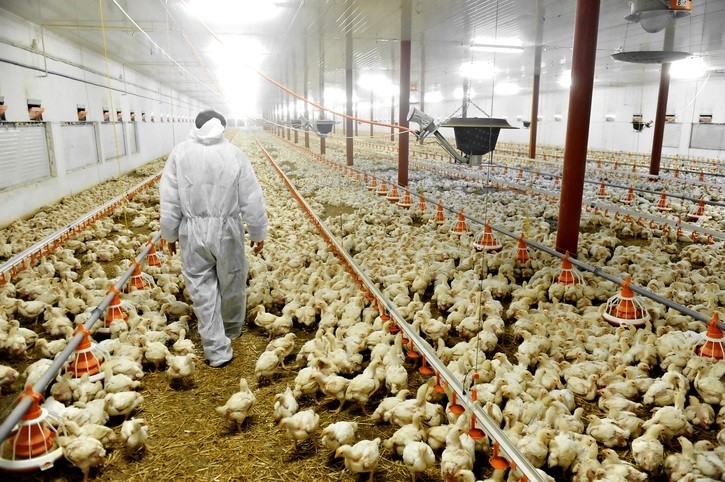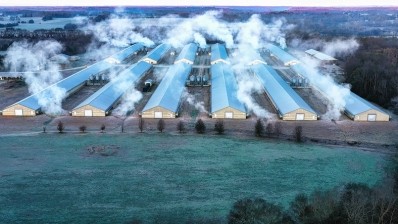Special Edition: Eubiotic developments
Tyson: The role of eubiotics in antibiotic free poultry production

We caught up with Philip Smith, nutritionist with Tyson Foods, to hear more about the work with that the company has been doing to support poultry production without the use of antibiotics and what challenges remain.
He spoke about the work Tyson was doing at the Amlan Summer International Poultry Seminar in August.
All the chickens raised for the Tyson retail brand are produced with no antibiotics ever (NAE), the company reported.
The label can be amended to recognize other aspects of poultry production, whether than involves the use of an all-vegetarian feed or an organic or GMO-free diet.
“We have one complex dedicated to do that – NAE+,” he told us of antibiotic-free production using a vegetarian diet.”
But he said the company was fighting hard to keep the use of animal protein and animal fat in poultry diets
Depending on the country, he said, there also can be a discussion regarding what the phrase “no antibiotics ever” covers in relation to the products that are allowed.
The US Department of Agriculture (USDA) considers ionophores, like monensin and salinomycin, to be antibiotics, he said. “The USDA classifies them all as antibiotics even though they’re only used in livestock,” he added.
“To meet the NAE [no antibiotics ever] requirement, we have to pull ionophores.”
The role of eubiotics in NAE production
However, even as companies like Tyson produce poultry flocks with minimal or no use of antibiotics there are ongoing challenges that producers have to consider, said Smith. Producers still need to control coccidiosis, support gut health and prevent necrotic enteritis.
“As far coccidia control, we have to use chemical coccidiostats,” he said. “Those chemicals aren’t antibiotics, they’re just anticoccidials.”
However, strains of coccidiosis can develop a resistance to the chemicals used meaning a rotation is needed, he said. “That doesn’t leave many options for cocidi control, it leaves you open to necrotic enteritis, as they don’t have any effect on that,” he added.
There also are vaccines available, he said. “Your cocci control depends on how well the vaccine is applied,” he added.
“Those are the kinds of the things that make NAE programs hard because you’ve got to control coccidiosis and you’ve got to control necrotic enteritis and without antibiotics and without ionophores that really ramps our challenges up and makes it harder,” said Smith. “I’m not saying it makes it impossible – we’re doing it all the time.”
To support poultry production without relying on the use of an antibiotic product there also are several interventions such as probiotics, saponins, essential oils that can be added to feed or water at specific times or for particular reasons, he said. “With every feed change we’ll come in with like a copper sulfate, or some sort of acidifiers or some sort of sanitizing thing in the drinking water – it’s not an antibiotic but it helps temper the feed changes and your challenge points,” he added.
Similarly, if a poultry house displays an increase in bird mortality, essential oils or acids may be added, he said. “We have things we can put in the feed all the time that aren’t antibiotics – we’re using like probiotics – bacillus, subtilis, there are many different kinds of probiotics – we’ll use some essential oils at times.”
“We’ll use those in the feed during the critical times and then we’ll pull them out,” he said. “The thing is they cost as much as, or more, than antibiotic and do about half as much good, and sometimes they work and sometimes they don’t.”
Additionally, the company adds enzymes to its poultry feed as another support for gut health, said Smith. It also has looked for ways to reduce the stress on birds through different management practices.
“We can definitely grow birds without antibiotics,” he said. “So we try these acids, the butyric acid, the saponins, the probiotics, the moss products and many more, we try those and someday we’ll come up with a combination that will be as good as antibiotics.”
Consumer led change questioned
Looking forward, there are some concerns market led developments could add to the challenges and costs poultry producers face, said Smith.
“What I’m afraid of is the stepping stone [effect],” he said of the efforts to reduce or eliminate the use of antibiotics in poultry production. Future changes could bring a focus on slower-growing birds, the use of only non-biotech feed ingredients or only vegetarian diets.
“Poultry by-product meal, feather meal, poultry fat these are things that are good feed ingredients,” he said. “They’re used in pet food a lot, but also used in animal feed.”
Tyson purchased the rendering company American Proteins, Inc. and AMPRO Products Inc. for $850m in May.
“For some reason, people think it’s more wholesome to feed an all-vegetarian diet, and we’re still 90% all vegetable based there’s just a little bit of animal protein, it helps balance the diet,” said Smith. “It has a lot of advantages to meeting the birds' requirements better ... It is a good mineral [source] and a good amino acid profile so it fits the birds nutrient requirements.”
The ingredient is of particular concern because using only vegetable-based oils in diets would increase feed prices without improving performance, he said. “I fight for that hard because if I took that away from me that’s going to cost me.”
“We recycle a lot of our poultry fat back into our diets so we’d have to have soy or corn oil or some other oil source or canola,” he said. “They’re great oil sources, but they just generally cost more than a blend or animal byproduct fat.”














